Clothing
Clothing is in Church Monument Details.
Culture, General Things, Church Monuments, Church Monument Details, Clothing, Belts
Maiden's Face Buckle
After 1423. St Peter's Church, Elford [Map]. Monument to John Stanley. Early Plate Bascinet Period. Maiden's Face Buckle. Eagle and Baby Crest; the legend associated with Sir John's descent from his ancestor, Sir Thomas Latham, whose wanted his barren wife to adopt his illegitimate son so he placed the baby in a nearby eagle's nest. His wife was delighted with this 'miracle' and took the child as her own.
Historic England states ... "Knight of circa 1370, alabaster, with bogus Gothic inscription by Richardson to Sir John Stanley, died 1474".
Mark Downing, President of the Church Monuments Society states on FB ... My research concludes c.1410. On a modern alabaster tomb-chest in the north-east corner of the south aisle. Stebbing Shaw quotes the inscription and expenses by Humphrey Stanley who probably acquired the effigy from a dissolved monastic house, with the inscription added c.1540 by possibly a Burton-on-Trent workshop. Restored and re-cut by Richardson in 1848/49. He states that he renewed the eagle crest, parts of the basinet, aventail, left arm, gauntlets, grip of the dagger, rowel spurs, spur straps, first part of the inscription and tomb-chest. Inscription on the right side of the slab: Orate pro aia d'ni Joh'is Stanley milit quondam d'ni de pype clyfton caumpuyle elforde et stotfolde et hui' Cantarie et capelle fundator' Anno d'ni Mil'simo CCCCMO Septuagesimo quarto. It is worth commenting that the rapier sword was not introduced until the sixteenth century and that this sword was cut into the slab when the inscription was added.
Humphrey Stanley: Around 1450 he was born to John Stanley and Elizabeth Vernon at Pipe, Staffordshire. On 19 Mar 1505 Humphrey Stanley died.
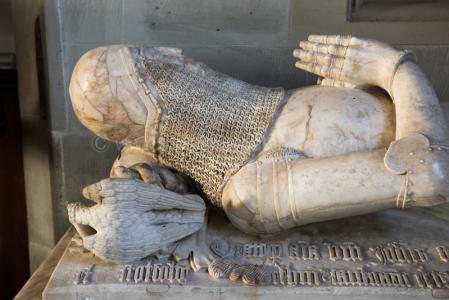
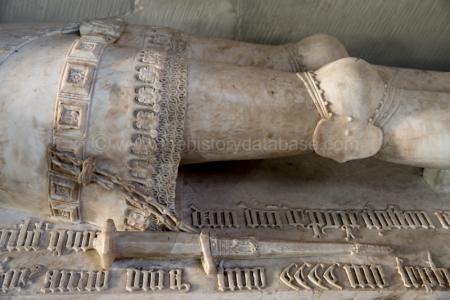
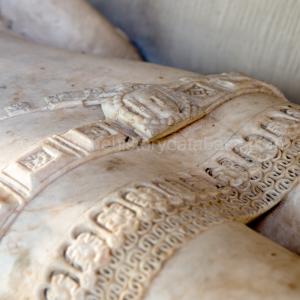
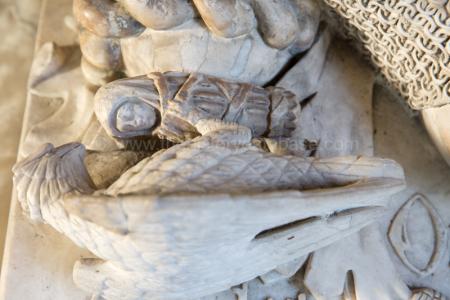
Culture, General Things, Church Monuments, Church Monument Details, Clothing, Chimere
Chimere. A garment worn by Anglican bishops in choir dress, and, formally as part of academic dress.
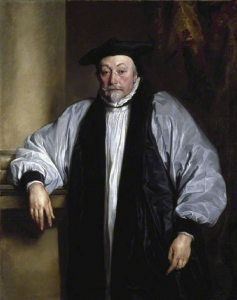 Around 1636 Anthony Van Dyck (age 36). Portrait of Archbishop William Laud (age 62). Wearing a black Chimere over his white Rochet.
Around 1636 Anthony Van Dyck (age 36). Portrait of Archbishop William Laud (age 62). Wearing a black Chimere over his white Rochet.
Culture, General Things, Church Monuments, Church Monument Details, Clothing, Female Headwear
Lappet
Lappet. A decorative flap, fold or hanging part of a headdress or garment.
Culture, General Things, Church Monuments, Church Monument Details, Clothing, Low Rounded Neckline
On 25 Feb 1387 John Grey aka Marmion (age 44) died in Spain. In 1400 Elizabeth St Quentin (age 53) died.
Monument in St Nicholas Church, West Tanfield [Map]. Camail and Jupon Period. Lancastrian Esses Collar. Hip Belt. Feathered Crest on Great Helm. Angels Supporting Pillow. His bascinet has decorated edges with the camail appearig to attach inside the bascinet. Decorated flat band. She wearing a unusual headress which appears to be a cross between Gabled Headress and Bongrace. Her dress long with a Low Rounded Neckline and appears to be decoated with an armorial: vair at the top, chevrons at the bottom, which may be  Marmion Arms or a variation of.
Marmion Arms or a variation of.
John Grey aka Marmion: In 1343 he was born to John Grey 1st Baron Grey and Avice Marmion Baroness Grey Rotherfield. Before 25 Feb 1387 John Grey aka Marmion and Elizabeth St Quentin were married. He a great x 4 grandson of King Henry "Curtmantle" II of England.
Elizabeth St Quentin: Before 1347 she was born to Herbert St Quentin and Mary Lisle.
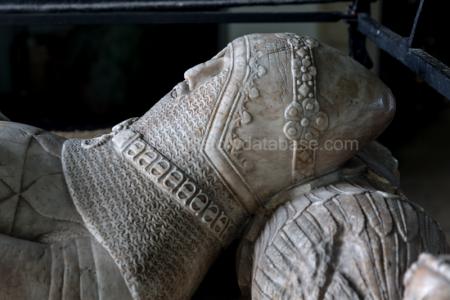
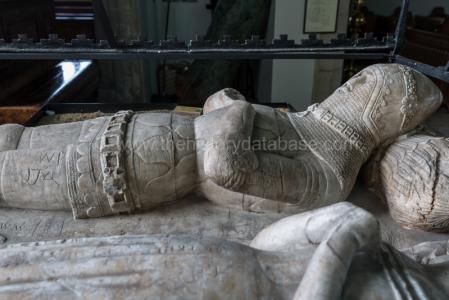
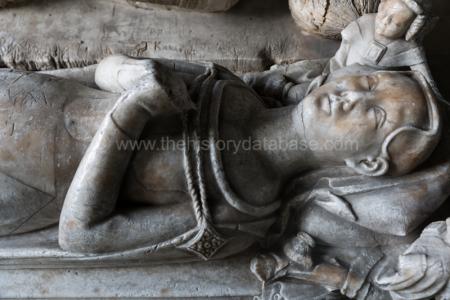
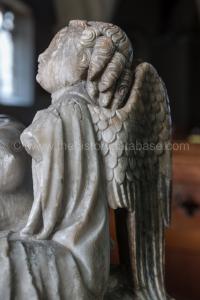
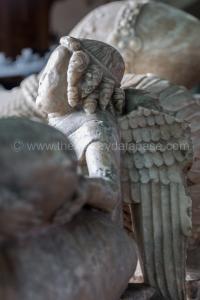
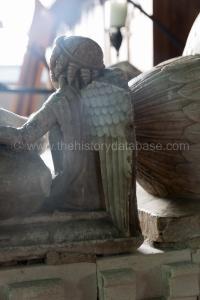
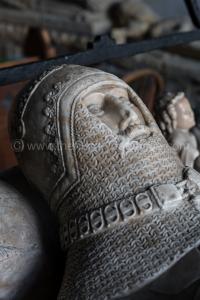
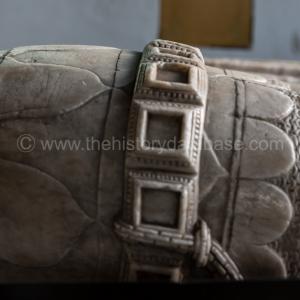
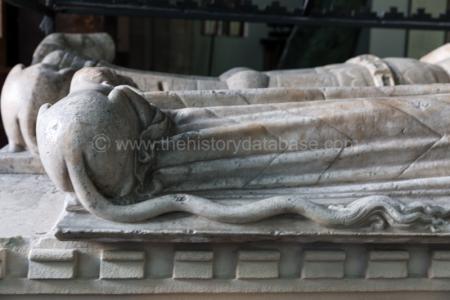
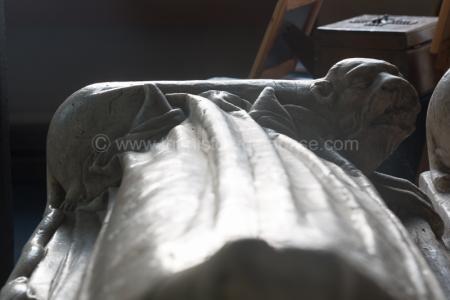
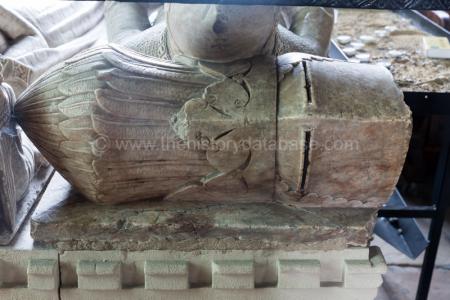
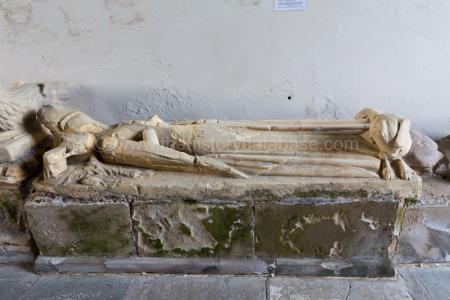
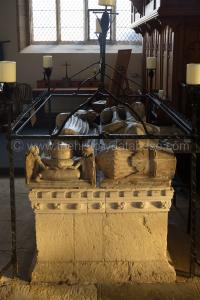
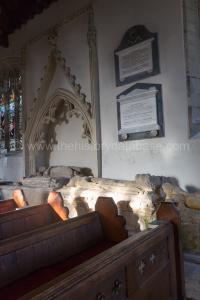
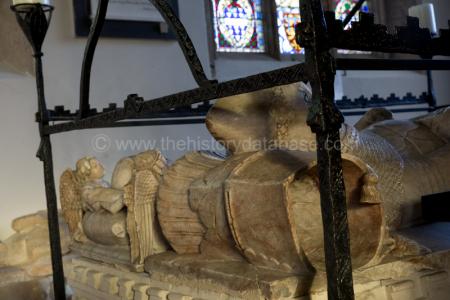
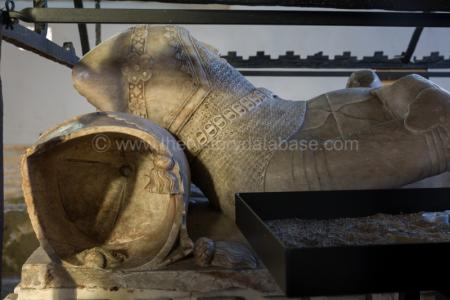
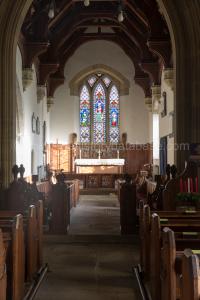
Culture, General Things, Church Monuments, Church Monument Details, Clothing, Male Hats
Beaver
Pepy's Diary. 17 Aug 1663. Thence home, where I dined, and after dinner comes our old mayde Susan to look for a gorgett that she says she has lost by leaving it here, and by many circumstances it being clear to me that Hannah, our present cook-mayde, not only has it, but had it on upon her necke when Susan came in, and shifted it off presently upon her coming in, I did charge her so home with it (having a mind to have her gone from us), that in a huff she told us she would be gone to-night if I would pay her her wages, which I was glad and my wife of, and so fetched her her wages, and though I am doubtful that she may convey some things away with her clothes, my wife searching them, yet we are glad of her being so gone, and so she went away in a quarter of an hour's time. Being much amused at this to have never a maid but Ashwell, that we do not intend to keep, nor a boy, and my wife and I being left for an hour, till my brother came in, alone in the house, I grew very melancholy, and so my brother being come in I went forth to Mrs. Holden's, to whom I formerly spoke about a girle to come to me instead of a boy, and the like I did to Mrs. Standing and also to my brother Tom (age 29), whom I found at an alehouse in Popinjay ally drinking, and I standing with him at the gate of the ally, Ashwell came by, and so I left Tom and went almost home with her, talking of her going away. I find that she is willing to go, and told her (though behind my back my wife has told her that it was more my desire than hers that she should go, which was not well), that seeing my wife and she could not agree I did choose rather (was she my sister) have her gone, it would be better for us and for her too. To which she willing agreed, and will not tell me anything but that she do believe that my wife would have some body there that might not be so liable to give me information of things as she takes her to be. But, however, I must later to prevent all that. I parted with her near home, agreeing to take no notice of my coming along with her, and so by and by came home after her. Where I find a sad distracted house, which troubles me. However, to supper and prayers and to bed. And while we were getting to bed my wife began to discourse to her, and plainly asked whether she had got a place or no. And the other answered that she could go if we would to one of our own office, to which we agreed if she would. She thereupon said no; she would not go to any but where she might teach children, because of keeping herself in use of what things she had earnt, which she do not here nor will there, but only dressing. By which I perceive the wench is cunning, but one very fit for such a place, and accomplished to be woman to any lady in the land. So quietly to sleep, it being a cold night. But till my house is settled, I do not see that I can mind my business of the office, which grieves me to the heart. But I hope all will over in a little time, and I hope to the best. This day at Mrs. Holden's I found my new low crowned beaver according to the present fashion made, and will be sent home to-morrow.
Pepy's Diary. 29 Nov 1663. Lord's Day. This morning I put on my best black cloth suit, trimmed with scarlett ribbon, very neat, with my cloake lined with velvett, and a new beaver, which altogether is very noble, with my black silk knit canons I bought a month ago. I to church alone, my wife not going, and there I found my Lady Batten in a velvet gown, which vexed me that she should be in it before my wife, or that I am able to put her into one, but what cannot be, cannot be. However, when I came home I told my wife of it, and to see my weaknesse, I could on the sudden have found my heart to have offered her one, but second thoughts put it by, and indeed it would undo me to think of doing as Sir W. Batten (age 62) and his Lady do, who has a good estate besides his office.
Culture, General Things, Church Monuments, Church Monument Details, Clothing, Rochet
Rochet. A vestment resembling a surplice, used chiefly by bishops and abbots.
Henry Machyn's Diary. 12 Aug 1560. The xij day of August was bered at Powlles master May the nuw dene of Powlles, and my lord of Londun (age 41) mad the sermon in ys rochett, bered hym.
Note. P. 241. Funeral of master May, dean of Paul's. William May, LL.D. He was the "new dean of Paul's," inasmuch as he had replaced Dr. Cole, but he had been previously dean from 1545 to the accession of Mary. At the time of his death he was designated to the archiepiscopal see of York: see in Dugdale's History of St. Paul's his epitaph, formerly in the choir of the old cathedral church.
Henry Machyn's Diary. 21 Feb 1561. The xxj day of Feybruary dyd pryche a-for the quen (age 27) and the consell master Skamler (age 41), the new bishop of Peterborow in ys chymner and ys whyt rochet.
 Around 1636 Anthony Van Dyck (age 36). Portrait of Archbishop William Laud (age 62). Wearing a black Chimere over his white Rochet.
Around 1636 Anthony Van Dyck (age 36). Portrait of Archbishop William Laud (age 62). Wearing a black Chimere over his white Rochet.
After 10 Dec 1646 a cenotaph to Bishop George Coke (deceased) was erected in his memory in the South East Transept of Hereford Cathedral [Map]. Effigy in Rochet, chimere, ruff and skull-cap, head on tasselled cushion, base and canopy modern.
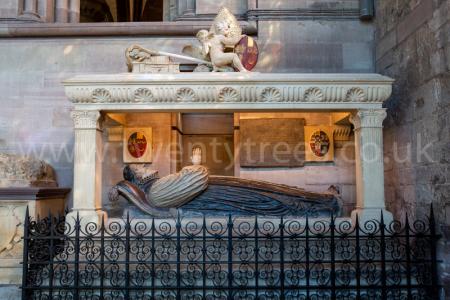
Culture, General Things, Church Monuments, Church Monument Details, Clothing, Tippett
Tippett. A woman's long fur scarf or shawl worn around the neck and shoulders.